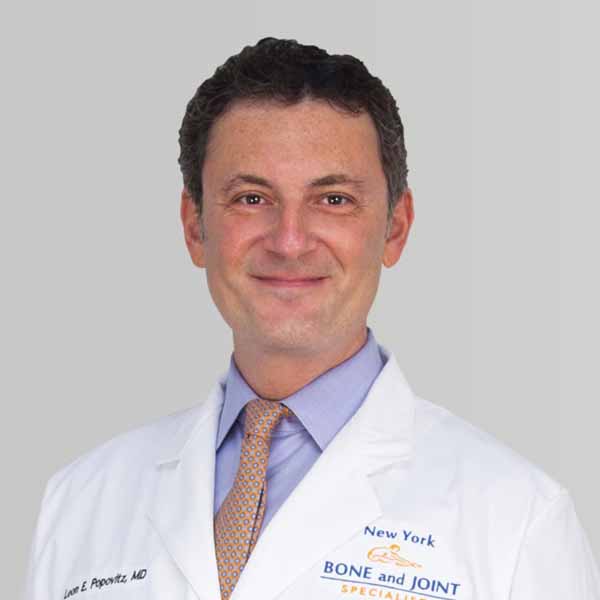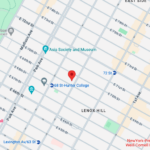New Yorkers walk everywhere: to the park, the grocery store, and the theater. It’s one of the joys of living in the city. And along your walks, you peer up at those gleaming skyscrapers. These simple activities shouldn’t hurt. But they might if you develop bone spurs in your foot, neck, or shoulder.
Bone spurs happen for several reasons, but they’re primarily the result of aging. About 80 percent of men and 60 percent of women over 50 develop bone spurs. Most don’t cause any symptoms, but when they do, walking and rotating your neck and shoulders can bring pain with every movement.
New Yorkers can depend on the outstanding orthopedists at New York Bone & Joint Specialists for exceptional and effective bone spur treatment. We always take a conservative-first approach when treating bone spurs, but our physicians are also highly trained in bone spur surgery when needed. We’re here to help you roam the city pain-free once again.
Understanding Bone Spurs: Definition and Formation
Bone spurs, medically known as osteophytes, grow on the outer edge of bones in joints you use frequently, such as your foot, knee, hip, shoulder, or spine. Despite their name, these outgrowths are actually small, smooth bumps rather than jagged protrusions. You can have bone spurs without any symptoms. But if a spur hits a nerve or irritates the soft tissue around your joint, it can cause pain, joint stiffness, and possibly numbness and tingling.
Essentially, bone spurs are your body’s reaction to stress. The bones in your joints wear down over the years because you put so much pressure on them. To repair that degeneration, your bone creates new bone tissue, forming a spur through a process called osteophytosis. Bone spurs also form where tendons and ligaments attach to bones in a joint.
What Causes Bone Spurs? Risk Factors and Development
The primary cause of bone spurs is osteoarthritis, a chronic condition where the cartilage protecting your bones breaks down as you age, causing bones to rub against each other. Your body then compensates by growing new bone tissue to fix the damage, which forms a bone spur. That’s why bone spurs are more common in older adults.
However, other risk factors can contribute to bone spur development:
- Athletic activities: Athletes who play sports with repetitive joint motions (running, baseball) can thin their cartilage over time
- Injuries: Joint or tendon injuries can trigger bone spur formation
- Structural abnormalities: Some people are born with unusual bone structures that increase risk
- Excess weight: Being overweight adds extra stress to your joints, which may respond by forming bone spurs
Bone spurs can also develop alongside other musculoskeletal disorders. For example, a spur may form due to repeated overhead motions like throwing a baseball. The spur then pinches your rotator cuff tendons, causing pain and limited shoulder movement. Runners risk developing plantar fasciitis (inflammation of the tough tissue connecting your heel to your toes) from overuse. Sometimes a heel spur grows in response to plantar fascia irritation, though you can have a heel spur without feeling pain from it. The foot pain you experience might actually be from plantar fasciitis itself.
Bone Spurs by Location: Symptoms and Impact
Bone spurs can grow on any joint, but they’re most commonly found in your heel, neck, and shoulder. Each location has distinct symptoms and pain patterns.
Foot and Heel Bone Spurs
Bone spurs in your foot protrude from the bottom of your heel bone where it attaches to the plantar fascia (the ligament between your heel and the ball of your foot). Heel bone spurs affect about 15 percent of the population, with runners at highest risk.
Symptoms of heel bone spurs include:
- Mild pain or tenderness in your heel when you put weight on it
- A slight but noticeable bump along your heel that’s sensitive to touch
- Calluses or corns at the heel spur site
- Swelling or warmth in your heel
Heel bone spurs are often mistaken for plantar fasciitis. While both cause foot pain, plantar fasciitis typically causes more intense pain, especially when taking your first step in the morning. These are separate conditions, but plantar fasciitis and heel spurs often develop together. A heel spur may form as your body tries to repair severe plantar fascia inflammation.
Neck Bone Spurs (Cervical Spine)
Bone spurs in your neck (cervical osteophytes) typically affect older adults due to arthritis that erodes the cartilage cushioning your spinal bones. Arthritis can also cause spinal disc deterioration. When discs shrink, they create friction between vertebrae, and bone spurs may emerge. Sports injuries, car accidents, and overuse injuries can also lead to cervical bone spurs.
Early symptoms of neck bone spurs:
- Swelling
- Tenderness
- Visible and palpable lump
As the condition progresses, symptoms may become more severe:
- Chronic dull pain
- Pain traveling from the bottom of your neck to your head
- Headaches
- Numbness or tingling that may extend to your arms and hands due to nerve compression
- Muscle spasms in your neck and shoulders
- Reduced range of motion (inability to turn your neck side to side)
Seek medical attention if symptoms reach this stage. In some cases, bone spurs can grow large enough to interfere with swallowing.
Shoulder Bone Spurs
Your shoulder is another common site for bone spurs. Like other joints, osteoarthritis is the leading cause of shoulder bone spurs. Repetitive motions from sports (tennis, baseball, golf) or work (painting, construction) also increase your risk.
Shoulder bone spur symptoms:
- Shoulder and neck pain that radiates to your upper back or arms
- Stiffness and decreased range of motion, particularly when lifting objects
- Tingling and numbness in your extremities
- Muscle weakness
- Muscle spasms
- Large spurs visible under your skin
Shoulder bone spurs increase your chance of a rotator cuff tear. Your rotator cuff is a network of tendons that attach your upper arm bone to your shoulder blade, providing stability and mobility. A bone spur can dig into a tendon and cause a rotator cuff tear, leading to pain, limited range of motion, and general shoulder weakness.
Comprehensive Bone Spur Treatment Options
Non-Surgical Treatment Approaches
Unfortunately, bone spurs don’t dissolve naturally. However, you can manage symptoms with non-surgical treatments that focus on strengthening your bones and reducing discomfort.
Conservative treatment options:
Rest: Avoid activities that cause joint pain.
Ice therapy: Apply a cold compress to your joint to reduce swelling. Always cover the compress with a towel to protect your skin.
Medications: Take over-the-counter pain relievers and anti-inflammatories like acetaminophen, ibuprofen, aspirin, and naproxen, but only for short periods.
Injections: An injection of anesthesia or cortisone into your joint can immediately reduce inflammation.
Supplements: Glucosamine and chondroitin contain cartilage elements and may boost joint lubrication. Vitamins D and K help your bones absorb calcium, an essential building block. Turmeric, collagen, and Boswellia serrata extract can reduce arthritis pain and inflammation.
Diet: Eat calcium-rich foods like milk, dairy, and cheese. Omega-3 foods (fish oil, flaxseeds) support joint health and can ease pain.
Exercise and physical therapy: Weight-bearing exercises (walking and jogging) stimulate bone growth, while resistance training with free weights builds muscle strength around your joint. A physical therapist can show you flexibility exercises and teach you how to adjust your movements to avoid joint strain.
Supportive devices: Stabilize your joint with a brace or other devices. For example, a shoe insert can relieve pressure on a heel bone spur.
Surgical Treatment for Bone Spurs
Conservative treatments are extremely effective at reducing bone spur pain and inflammation while improving mobility, but they don’t eliminate the spur. If you experience persistent pain after conservative therapies, surgery may be the next step.
The surgery can be performed as either an open operation (requiring a larger incision) or an arthroscopic procedure that enters your joint through a tiny incision and removes the spur using smaller instruments.
Depending on your spur’s location and symptom severity, your surgeon will perform either:
- Decompression surgery to relieve nerve or tendon compression
- Osteophytectomy to remove the spur entirely
You may go home the same day or stay for a short hospital visit. You might experience minor post-operative pain and be advised to avoid certain activities to prevent joint stress. Keep bandages dry and clean, and report any signs of infection.
After completing a physical therapy program, you’ll gradually resume normal activities. Your timeline depends on your doctor’s advice and your job requirements.
Why Choose New York Bone & Joint Specialists for Bone Spur Treatment
Bone spurs may be small, but they can significantly impact your quality of life. As a leading orthopedic practice and sports medicine facility, New York Bone & Joint Specialists takes pride in our commitment to outstanding patient care. We have the skills and expertise to relieve your pain and quickly get you back to your lifestyle, whether that’s jogging in Central Park or sightseeing around town.
Here’s what sets us apart:
- We’re board-certified orthopedic specialists with advanced training in musculoskeletal conditions, including joint bone spurs
- We use cutting-edge technology and diagnostic techniques to ensure accurate diagnoses
- We’re skilled orthopedic surgeons who use minimally invasive techniques for quicker recovery when surgery is needed
- We provide comprehensive treatment plans and follow you from initial diagnosis to complete recovery with our physical therapy team
- 90% of our patients recover fully without surgery
Ready to Get Relief?
We’re committed to preserving your natural joint structure and getting you back to comfortable, full movement as quickly as possible. Our patients consistently praise our dedication to their complete recovery with minimal discomfort.
Schedule Your Bone Spur Consultation in NYC
Frequently Asked Questions About Bone Spurs
What is a bone spur and how does it form?
Bone spurs are your body’s natural reaction to stress. When a joint is damaged due to osteoarthritis (which thins cartilage in the joint) or overuse, your bones compensate by building extra bone tissue, which forms into a spur. Spurs are typically small, round bumps on the edge of bones. Most don’t cause symptoms, but they can if one hits a nerve or irritates soft tissue.
Can you dissolve bone spurs naturally without surgery?
Unfortunately, bone spurs don’t dissolve naturally. However, you can manage symptoms with conservative therapies like icing, taking pain medications, and using natural supplements. Physical therapy can help build muscle strength and improve joint movement too. But the only way to completely eliminate the spur is through surgery.
What causes bone spurs in the foot and heel?
Persistent stress on your foot ligaments and tendons often leads to heel bone spurs. Sometimes, inflammation of the plantar fascia (strong tissue connecting your heel to your toes) causes plantar fasciitis. While plantar fasciitis is separate from bone spurs, constant plantar fascia irritation can stimulate bone spur development.
When is surgery necessary for bone spurs?
We consider surgery a last resort when other non-surgical treatments fail to provide relief. The surgery can be done arthroscopically for minimal scarring and tissue damage. Surgery can relieve tendon and tissue constriction in your joint or remove the spur entirely.
How long is recovery from bone spur surgery?
There’s no set timeline for bone spur surgery recovery as it depends on the type of surgery performed. You should feel better within several days to a few weeks. You can return to normal activities when you feel stronger and have full joint movement restored.












